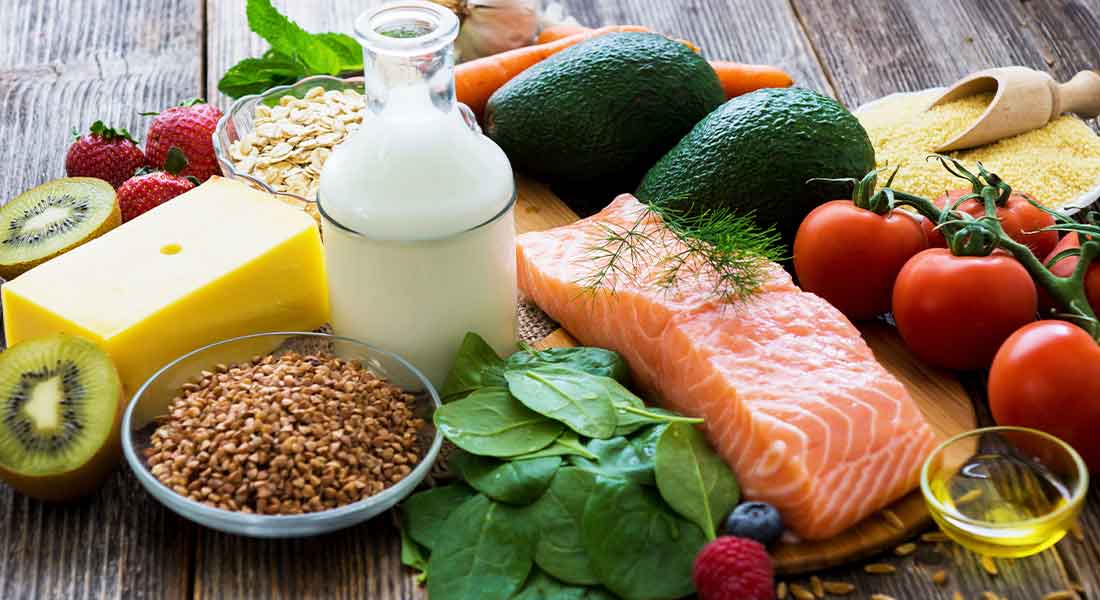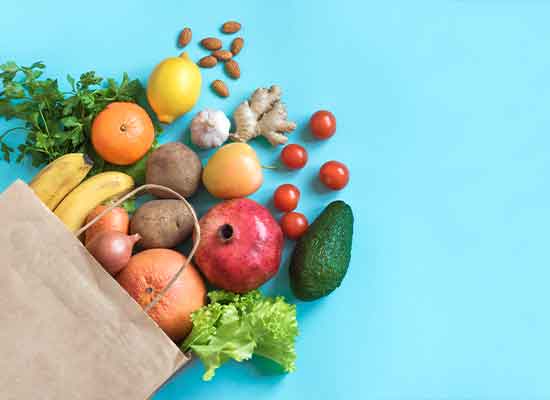 Contact
About Us
Articles
Home
Contact
About Us
Articles
Home

A simple scroll of the latest health news or social media will tell you a handful of foods you “can't” have if you want to be healthy. And don't get me wrong; there are certain foods you should limit as part of a healthy lifestyle, especially if you have heart disease or diabetes. However, I've found that it's a lot easier to eat healthier if you focus on what you can have and will benefit you instead of what you should limit.
So, read on to learn more about what nutrients those over the age of 50 years should include in their diet and an example of five foods you can include on your plate today that will provide you such nutrients. Next, I'll provide tips on foods and drinks you should limit to reduce the risk of chronic disease over time. And finally, I'll explain how you can use such foods in delicious meal and snack options today.
As you grow older, it's even more important than ever to make sure you eat enough of certain nutrients each day to stay your healthiest. It is especially true for older adults to choose foods and drinks that can help support optimal bone and muscle health. This is because such factors of health will help you maintain mobility and independence well into your golden years. Let's discuss some of these nutrients vital for those over 50 years of age.
Those over the age of 50 years, and especially those over the age of 70, need plenty of calcium in their diet to help maintain bone health. This nutrient is important because it helps keep bones strong to in turn reduce risk of fractures, which can lower quality of life for older adults. Foods and beverages that contain calcium include:
It's important to note though that dark-green leafy vegetables that contain calcium are much lower in calcium content than fortified and dairy products (i.e. 1 cup soy milk or milk contains 299 milligrams of calcium, while a half cup of cooked spinach contains 123 milligrams of calcium).
Also, spinach and collard greens contain compounds known as oxalic acid and phytic acid that decrease absorption of calcium in the body. This makes such vegetables only about 5% bioavailable to your body, while dairy products and milks are about 27% bioavailable. Therefore, do not rely on such vegetables to provide you your calcium content daily.
If you do not eat enough of fortified or other calcium-containing foods and drinks daily, then it would be best to take a dietary supplement to ensure you consume enough calcium daily. But make sure that you take your calcium supplement with plenty of vitamin D since, as you'll see, the two work together to support optimal bone health. Most older adults need about 1,200 milligrams of calcium daily.
If you take a calcium supplement, then taking vitamin D with it is a must. This is because vitamin D helps to increase absorption of calcium in the body for optimal positive impact on your bone health. You can find vitamin D in good amounts in cod liver oil, fatty fish like cod, trout and salmon, as well as in fortified cereals and beverages.
But an even easier way to make sure you have enough vitamin D each day is to soak up some sun. Experts suggest that for optimal vitamin D absorption in the body, you should be outside in the sun for about five to 30 minutes between 10 a.m. and 4 p.m., when the sun is at its peak, at least twice a week to your face, arms, hands and legs with no sunscreen.
However, if you feel like you don't go outside much or don't consume much vitamin-D rich food, then you should add a vitamin D supplement to your daily routine. Most adults need about 600 IU (international units) of vitamin D daily.
But if you are deficient in vitamin D, then your doctor may place you on a higher dosage to help you reach healthy levels. You should have your doctor check your vitamin D labs once a year to make sure you are within healthy levels. It is not always a usual part of your annual labs, so you may have to request them.
As adults reach the age of 50 years, it may be harder for your body to absorb vitamin B12. Without this important vitamin, you could develop a type of anemia known as megaloblastic anemia, or B12 deficiency. Symptoms of this type of anemia may include:
Therefore, be sure to consume plenty of vitamin B12 daily. You can find vitamin B12 mostly in animal products like:
If you consume a vegetarian diet or just don't eat a lot of animal products, then you may need to take a vitamin B12 supplement. Most adults need about 2.4 micrograms daily for optimal health. It's also important to limit alcohol intake since alcohol abuse can increase one's risk of vitamin B12 deficiency. Also, those who have conditions like Crohn's and celiac disease may also be at risk for low vitamin B12.
Every healthy lifestyle requires enough fiber intake daily. Even though it is not technically digested by the body, fiber helps to:
And if that wasn't enough, research shows that fiber can help control blood glucose levels and lower one's risk of heart disease. Most adults should consume around 25 grams of fiber per day, or 14 grams per 1,000 calories eaten daily
There are endless foods that can provide you the nutrients you need to stay your healthiest after the age of fifty. But here are five examples of foods you can add to your meals and snacks today to ensure optimal health today.
This creamy and tart food is made from fermented milk, so it is full of healthy bacteria to support gut health. Not to mention that yogurt is a protein-rich food and contains about 450 milligrams of calcium, or nearly 40% of the recommended daily value for adults.
Both beans and lentils are a rich source of fiber, potassium and vitamin B12, or folate. A typical serving size of beans and lentils is about one-half cup and contains about 7 to 9 grams of both fiber and protein.
Well-known as a staple breakfast food, eggs are a great way to meet your protein needs any time of the day. One large egg is equal to about 6 grams of protein. And unlike widely held belief, eggs fit just fine as part of a healthy diet.
In fact, a 2022 study shows that two eggs daily had no impact on the heart health markers of healthy individuals. Furthermore, a 2021 study shows that whole egg intake has no impact on the cognitive function of older adults.
Finally, another 2021 study shows that intake of less than two eggs per day reveals no elevated risk of type 2 diabetes, while intake of less than six eggs per week shows no impact on heart health markers. However, studies show that in the general population, increased egg intake does not have any impact on heart health risk.
If you enjoy the texture of scrambled eggs but would like to reduce your egg intake or supplement your protein intake with a vegetarian protein option, then tofu may work well for you. Tofu is a nonfermented soybean food product that provides a good source of protein and calcium. One-half cup, or about four ounces of tofu contains about 12 grams of protein and a bit over 400 milligrams of calcium.
This fatty fish is a good source of protein and healthy fats. About three ounces of salmon contain about 21 grams of protein and provide a rich source of omega-3 fatty acids that are beneficial for heart health. Also, a 2016 study shows that omega-3 fatty acid intake through supplements can have positive effects on memory function in older adults. Finally, a 2022 study shows that omega-3 fatty acid supplements may help improve heart health markers such as lipoprotein levels in older adults.
The key to improving your plate each day is to include a source of protein and fiber with each meal and snack. This will not only keep your lean muscle strong but will also keep your digestive system healthy. But along with including certain foods and drinks daily for your best health, it's also important to remember to limit certain foods to lower your risk of chronic diseases like heart disease and diabetes.
Research shows that the following eating habits can increase risk of cardiometabolic conditions like type 2 diabetes and heart disease:

Therefore, use the following tips to lower your risk of such conditions:
Knowing what to eat is one thing but trying to fit it into your daily routine can be a more difficult task. Therefore, read below for some delicious ideas on how to fit the healthy foods above into your healthy lifestyle routine.
Eating healthy is different for everyone depending on your food allergies, intolerances and food preferences, not to mention your budget. That is why you should never feel down on yourself if you can't manage the same eating plan as your friend, neighbor or relative. If you can try to consume enough of the vital nutrients daily through foods and supplements, then your body will be happy and healthy as it can be.
Alliance America is an insurance and financial services company dedicated to the art of personal financial planning. Our financial professionals can assist you in maximizing your retirement resources and achieving your future goals. We have access to an array of products and services, all focused on helping you enjoy the retirement lifestyle you want and deserve. You can request a no-cost, no-obligation consultation by calling (833) 219-6884 today.


